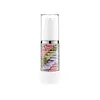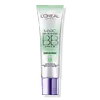What's inside
What's inside
 Key Ingredients
Key Ingredients

 Benefits
Benefits

 Concerns
Concerns

 Ingredients Side-by-side
Ingredients Side-by-side

Water
Skin ConditioningPropylene Glycol
HumectantGlycerin
HumectantCaprylic/Capric Triglyceride
MaskingDimethicone
EmollientTrimethylsiloxysilicate
EmollientCyclopentasiloxane
EmollientCentella Asiatica Extract
CleansingPhenoxyethanol
PreservativeC13-14 Isoparaffin
EmollientPolyacrylamide
Allantoin
Skin ConditioningSodium Hyaluronate
HumectantOlive Oil PEG-7 Esters
EmollientChlorphenesin
AntimicrobialLaureth-7
EmulsifyingXanthan Gum
EmulsifyingCI 77891
Cosmetic ColorantCI 77492
Cosmetic ColorantCI 77742
Cosmetic ColorantCI 74260
Cosmetic ColorantWater, Propylene Glycol, Glycerin, Caprylic/Capric Triglyceride, Dimethicone, Trimethylsiloxysilicate, Cyclopentasiloxane, Centella Asiatica Extract, Phenoxyethanol, C13-14 Isoparaffin, Polyacrylamide, Allantoin, Sodium Hyaluronate, Olive Oil PEG-7 Esters, Chlorphenesin, Laureth-7, Xanthan Gum, CI 77891, CI 77492, CI 77742, CI 74260
Water
Skin ConditioningIsododecane
EmollientDimethicone
EmollientIsohexadecane
EmollientGlycerin
HumectantPEG-10 Dimethicone
Skin ConditioningMethyl Methacrylate Crosspolymer
Butylene Glycol
HumectantDisteardimonium Hectorite
StabilisingPentylene Glycol
Skin ConditioningPanthenol
Skin ConditioningCetyl PEG/PPG-10/1 Dimethicone
EmulsifyingPhenoxyethanol
PreservativeAcrylates/Ammonium Methacrylate Copolymer
Polyglyceryl-4 Isostearate
EmulsifyingSodium Chloride
MaskingHexyl Laurate
EmollientBoron Nitride
AbsorbentCaprylyl Glycol
EmollientSynthetic Fluorphlogopite
Triethyl Citrate
MaskingDisodium Stearoyl Glutamate
CleansingTocopherol
AntioxidantAluminum Hydroxide
EmollientPentaerythrityl Tetra-Di-T-Butyl Hydroxyhydrocinnamate
AntioxidantCI 77891
Cosmetic ColorantCI 77491
Cosmetic ColorantCI 77492
Cosmetic ColorantCI 77499
Cosmetic ColorantCI 77288
Cosmetic ColorantWater, Isododecane, Dimethicone, Isohexadecane, Glycerin, PEG-10 Dimethicone, Methyl Methacrylate Crosspolymer, Butylene Glycol, Disteardimonium Hectorite, Pentylene Glycol, Panthenol, Cetyl PEG/PPG-10/1 Dimethicone, Phenoxyethanol, Acrylates/Ammonium Methacrylate Copolymer, Polyglyceryl-4 Isostearate, Sodium Chloride, Hexyl Laurate, Boron Nitride, Caprylyl Glycol, Synthetic Fluorphlogopite, Triethyl Citrate, Disodium Stearoyl Glutamate, Tocopherol, Aluminum Hydroxide, Pentaerythrityl Tetra-Di-T-Butyl Hydroxyhydrocinnamate, CI 77891, CI 77491, CI 77492, CI 77499, CI 77288
Ingredients Explained
These ingredients are found in both products.
Ingredients higher up in an ingredient list are typically present in a larger amount.
Ci 77492 is also hydrated iron III oxide. It's sole purpose is to give a yellow hue to products.
Iron III oxides are classified as inorganic chemicals for coloring.
Synthetically created Ci 77492 is considered safer than those naturally found. This is because the synthetically created version may contain less impurities. Iron oxides are generally non-toxic and non-allergenic.
Learn more about CI 77492Ci 77891 is a white pigment from Titanium dioxide. It is naturally found in minerals such as rutile and ilmenite.
It's main function is to add a white color to cosmetics. It can also be mixed with other colors to create different shades.
Ci 77891 is commonly found in sunscreens due to its ability to block UV rays.
Learn more about CI 77891Dimethicone is a type of synthetic silicone created from natural materials such as quartz.
What it does:
Dimethicone comes in different viscosities:
Depending on the viscosity, dimethicone has different properties.
Ingredients lists don't always show which type is used, so we recommend reaching out to the brand if you have questions about the viscosity.
This ingredient is unlikely to cause irritation because it does not get absorbed into skin. However, people with silicone allergies should be careful about using this ingredient.
Note: Dimethicone may contribute to pilling. This is because it is not oil or water soluble, so pilling may occur when layered with products. When mixed with heavy oils in a formula, the outcome is also quite greasy.
Learn more about DimethiconeGlycerin is already naturally found in your skin. It helps moisturize and protect your skin.
A study from 2016 found glycerin to be more effective as a humectant than AHAs and hyaluronic acid.
As a humectant, it helps the skin stay hydrated by pulling moisture to your skin. The low molecular weight of glycerin allows it to pull moisture into the deeper layers of your skin.
Hydrated skin improves your skin barrier; Your skin barrier helps protect against irritants and bacteria.
Glycerin has also been found to have antimicrobial and antiviral properties. Due to these properties, glycerin is often used in wound and burn treatments.
In cosmetics, glycerin is usually derived from plants such as soybean or palm. However, it can also be sourced from animals, such as tallow or animal fat.
This ingredient is organic, colorless, odorless, and non-toxic.
Glycerin is the name for this ingredient in American English. British English uses Glycerol/Glycerine.
Learn more about GlycerinPhenoxyethanol is a preservative that has germicide, antimicrobial, and aromatic properties. Studies show that phenoxyethanol can prevent microbial growth. By itself, it has a scent that is similar to that of a rose.
It's often used in formulations along with Caprylyl Glycol to preserve the shelf life of products.
Water. It's the most common cosmetic ingredient of all. You'll usually see it at the top of ingredient lists, meaning that it makes up the largest part of the product.
So why is it so popular? Water most often acts as a solvent - this means that it helps dissolve other ingredients into the formulation.
You'll also recognize water as that liquid we all need to stay alive. If you see this, drink a glass of water. Stay hydrated!
Learn more about Water